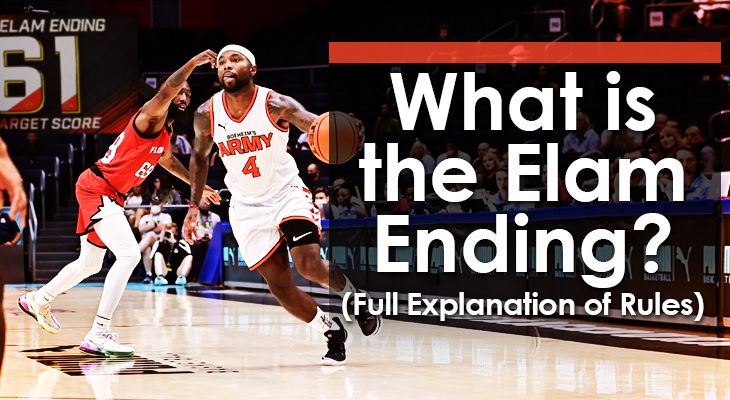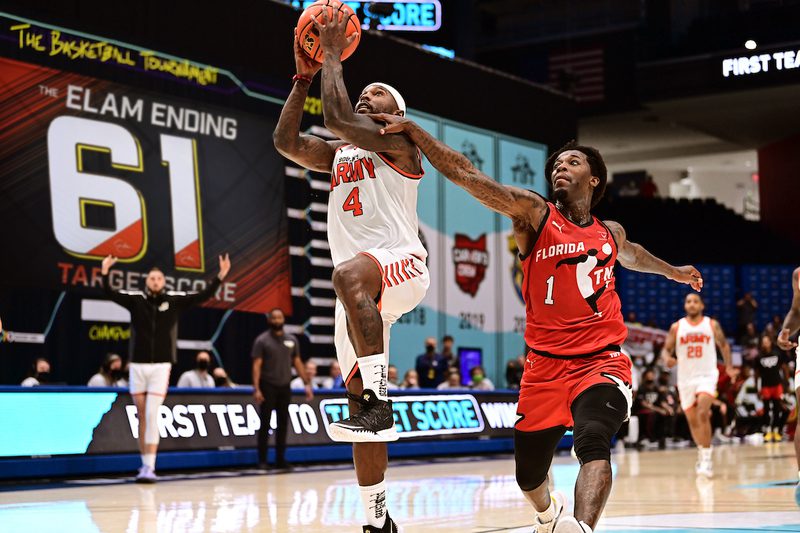
When watching the end of a close basketball game, you'll likely see numerous fouls by the trailing team as they attempt to extend the game.
The "Elam Ending" was created to mitigate late-game fouling and maintain a natural flow to the basketball game until the final buzzer sounds.
While it's still a relatively new concept, it has grown in popularity and even made its way to the highest levels of basketball.
In this post, we’ll highlight how the Elam Ending works, where it started, and how it's being used across the basketball landscape.
What is the Elam Ending?
The Elam Ending is an alternate way to finish basketball games.
Teams win the game by reaching a *target score* which is determined with 4 minutes left.
In this version, the clock is removed from the equation in an attempt to eliminate the boring *late-game fouling* that occurs when the trailing team attempts to extend the game.
These late-game fouls (a) ruin the "flow" of the game and (b) make basketball games last much longer than they should.
Remember when you told a friend or family member -- "There are only 3 minutes left!" -- but that turned into 20-minutes of fouling and free throws?
Elam Ending fixes that.
How Elam Ending Works
The clock is turned off at the first dead ball with under four minutes left in the game.
A *target score* is then determined by taking the leading team's current score and adding a certain number of points to it.
The first team to reach the target score wins the game.
Simple, huh?
Here's an example:
The Basketball Tournament was one of the early adopters of the Elam Ending.
They add eight points to the leading team's score to set the target score. So if the score is 88-80 at the first dead ball with under 4 minutes left in the game, they will set the target score at 96. The first team to reach the target score wins.
The best part?
This means that EVERY GAME ends on a made basket, eliminating dull + boring finishes.
A "game-winner" for every game!
Who Started Elam Ending?
The Elam Ending is named after its founder, Nick Elam.
Nick Elam is a professor at Ball State University and began studying data in 2004, trying to find a better way to end basketball games.
His research of over 2,000 NBA and college basketball games verified his hypothesis that the trailing team fouls to prolong games.
His data analysis found that while trailing teams fouled to keep themselves in the game, they were only successful 1.5% of the time.
It was a strategy that not only made games hard to watch, but was also very ineffective.
Nick then came up with the ‘Hybrid Duration Format,’ which has been renamed the Elam Ending.
Here's an interview you might enjoy:
What Leagues Use the Elam Ending?
1. The Basketball Tournament
After Nick Elam came up with the concept for the Elam Ending, he emailed the founders of "The Basketball Tournament" about his new system.
The Basketball Tournament is a single-elimination, winner-takes-all tournament that's paid out over $10 million in prizes since its inception in 2014. It has some of the top non-NBA talent.
In 2017, The Basketball Tournament tested out the Elam Ending...
And by 2018, every game utilized the alternate ending.
Players in TBT have fully embraced the Elam Ending as it's made for exciting ends to games that have garnered a lot of attention.
2. NBA All-Star Game
By 2020, the NBA had even implemented the Elam Ending.
The ending isn't used for regular games, but has been adopted in the All-Star Game.
The NBA All-Star game is known to be non-competitive and generally not fun to watch...
(it's usually just players dunking freely and trying not to get hurt)
But with the Elam Ending being implemented, players got serious and the intensity picked up.
TV ratings spiked in the 4th quarter as the game grew more competitive and people were curious about the Elam Ending.
3. The NBA G League
The NBA's G League adopted the Elam Ending for any game that goes into overtime.
If the game is tied after regulation, they will shut off the clock and the first team to score seven points in the overtime period will win.
For example, if the game is 95-95, they will set the target score at 102.
The G League also has a showcase for NBA scouts called the Las Vegas Showcase that will utilize the Elam Ending for all games.
Instead of playing the fourth quarter, they take the winning team's score, add 25 points, and make that the target score.
4. Pick-up Basketball
Pick-up basketball has long been using an Elam Ending style.
Clocks are rarely used in a pick-up setting.
Instead, teams usually play to a set number of points.
Which is generally the same concept that the Elam Ending uses.

Conclusion
The Elam Ending is an exciting new way to end basketball games.
Its purpose is to eliminate the excessive fouling that plagues the ends of games, keeping the "flow" of the game intact.
While still relatively new, it has already made its way to the biggest parts of the basketball world and will likely only continue to grow.
